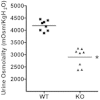GSK3beta mediates renal response to vasopressin by modulating adenylate cyclase activity
- PMID: 20056751
- PMCID: PMC2831860
- DOI: 10.1681/ASN.2009060672
GSK3beta mediates renal response to vasopressin by modulating adenylate cyclase activity
Abstract
Glycogen synthase kinase 3beta (GSK3beta), a serine/threonine protein kinase, is a key target of drug discovery in several diseases, including diabetes and Alzheimer disease. Because lithium, a potent inhibitor of GSK3beta, causes nephrogenic diabetes insipidus, GSK3beta may play a crucial role in regulating water homeostasis. We developed renal collecting duct-specific GSK3beta knockout mice to determine whether deletion of GSK3beta affects arginine vasopressin-dependent renal water reabsorption. Although only mildly polyuric under normal conditions, knockout mice exhibited an impaired urinary concentrating ability in response to water deprivation or treatment with a vasopressin analogue. The knockout mice had reduced levels of mRNA, protein, and membrane localization of the vasopressin-responsive water channel aquaporin 2 compared with wild-type mice. The knockout mice also expressed lower levels of pS256-AQP2, a phosphorylated form crucial for membrane trafficking. Levels of cAMP, a major regulator of aquaporin 2 expression and trafficking, were also lower in the knockout mice. Both GSK3beta gene deletion and pharmacologic inhibition of GSK3beta reduced adenylate cyclase activity. In summary, GSK3beta inactivation or deletion reduces aquaporin 2 expression by modulating adenylate cyclase activity and cAMP generation, thereby impairing responses to vasopressin in the renal collecting duct.
Figures








Similar articles
-
Adenylate cyclase 6 determines cAMP formation and aquaporin-2 phosphorylation and trafficking in inner medulla.J Am Soc Nephrol. 2010 Dec;21(12):2059-68. doi: 10.1681/ASN.2010040409. Epub 2010 Sep 23. J Am Soc Nephrol. 2010. PMID: 20864687 Free PMC article.
-
Disruption of prostaglandin E2 receptor EP4 impairs urinary concentration via decreasing aquaporin 2 in renal collecting ducts.Proc Natl Acad Sci U S A. 2015 Jul 7;112(27):8397-402. doi: 10.1073/pnas.1509565112. Epub 2015 Jun 22. Proc Natl Acad Sci U S A. 2015. PMID: 26100911 Free PMC article.
-
The contribution of collecting duct NOS1 to the concentrating mechanisms in male and female mice.Am J Physiol Renal Physiol. 2019 Sep 1;317(3):F547-F559. doi: 10.1152/ajprenal.00180.2019. Epub 2019 Jun 26. Am J Physiol Renal Physiol. 2019. PMID: 31241990 Free PMC article.
-
Regulation of aquaporin-2 trafficking.Handb Exp Pharmacol. 2009;(190):133-57. doi: 10.1007/978-3-540-79885-9_6. Handb Exp Pharmacol. 2009. PMID: 19096775 Review.
-
Glycogen synthase kinase-3 regulation of urinary concentrating ability.Curr Opin Nephrol Hypertens. 2012 Sep;21(5):541-6. doi: 10.1097/MNH.0b013e32835571d4. Curr Opin Nephrol Hypertens. 2012. PMID: 22691876 Free PMC article. Review.
Cited by
-
Glycogen synthase kinase-3β promotes cyst expansion in polycystic kidney disease.Kidney Int. 2015 Jun;87(6):1164-75. doi: 10.1038/ki.2014.427. Epub 2015 Jan 28. Kidney Int. 2015. PMID: 25629553 Free PMC article.
-
Cyclic AMP and glycogen synthase kinase 3 form a regulatory loop in spermatozoa.J Cell Physiol. 2018 Sep;233(9):7239-7252. doi: 10.1002/jcp.26557. Epub 2018 Mar 25. J Cell Physiol. 2018. PMID: 29574946 Free PMC article.
-
Molecular mechanisms regulating aquaporin-2 in kidney collecting duct.Am J Physiol Renal Physiol. 2016 Dec 1;311(6):F1318-F1328. doi: 10.1152/ajprenal.00485.2016. Epub 2016 Oct 19. Am J Physiol Renal Physiol. 2016. PMID: 27760771 Free PMC article. Review.
-
Lithium Chloride and GSK3 Inhibition Reduce Aquaporin-2 Expression in Primary Cultured Inner Medullary Collecting Duct Cells Due to Independent Mechanisms.Cells. 2020 Apr 23;9(4):1060. doi: 10.3390/cells9041060. Cells. 2020. PMID: 32340354 Free PMC article.
-
Aquaporin-2 regulation in health and disease.Vet Clin Pathol. 2012 Dec;41(4):455-70. doi: 10.1111/j.1939-165x.2012.00488.x. Epub 2012 Nov 6. Vet Clin Pathol. 2012. PMID: 23130944 Free PMC article. Review.
References
-
- Mukai F, Ishiguro K, Sano Y, Fujita SC: Alternative splicing isoform of tau protein kinase I/glycogen synthase kinase 3beta. J Neurochem 81: 1073–1083, 2002 - PubMed
-
- MacAulay K, Doble BW, Patel S, Hansotia T, Sinclair EM, Drucker DJ, Nagy A, Woodgett JR: Glycogen synthase kinase 3alpha-specific regulation of murine hepatic glycogen metabolism. Cell Metab 6: 329–337, 2007 - PubMed
Publication types
MeSH terms
Substances
Grants and funding
LinkOut - more resources
Full Text Sources
Other Literature Sources
Molecular Biology Databases

